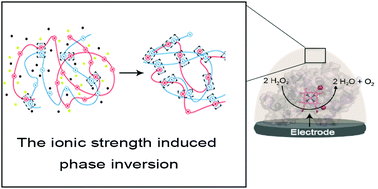Our official English website, www.x-mol.net, welcomes your
feedback! (Note: you will need to create a separate account there.)
Direct bioelectrocatalysis by redox enzymes immobilized in electrostatically condensed oppositely charged polyelectrolyte electrode coatings.
Analyst ( IF 3.6 ) Pub Date : 2019-12-19 , DOI: 10.1039/c9an02168j Koun Lim 1 , Monika Sima , Russell J Stewart , Shelley D Minteer
Analyst ( IF 3.6 ) Pub Date : 2019-12-19 , DOI: 10.1039/c9an02168j Koun Lim 1 , Monika Sima , Russell J Stewart , Shelley D Minteer
Affiliation

|
The immobilization of enzymes on an electrode surface is critical in preserving enzyme activity and providing a sufficient electron transfer pathway for bioelectrocatalysis. Here, we present a novel single-step, cross-linker free immobilization for direct bioelectrocatalysis using an ionic strength induced phase inversion of oppositely charged polyelectrolytes. Cationic poly-guanidinyl-propyl-methacrylate (pGPMA, PG) and anionic inorganic polyphosphate, sodium hexametaphosphate (P6) were used to make an electrostatically condensed phase (PGP6). A mixture of PGP6 and laccase (LAC) from Tramates versicolor or HRP (HRP) from Armoracia rusticana were deposited on the electrode surface and were submerged in DI water to form white porous electrode coatings. Each electrode showed a current generation corresponding to the respective substrates via direct bioelectrocatalysis.
中文翻译:

氧化还原酶直接生物电催化固定在静电冷凝的带相反电荷的聚电解质电极涂层中。
酶在电极表面的固定化对于保持酶活性并为生物电催化提供足够的电子转移途径至关重要。在这里,我们提出了一种新颖的单步,无交联剂的固定化方法,用于直接生物电催化,该方法利用离子强度引起的带相反电荷的聚电解质的相转化。阳离子聚甲基丙烯酸胍基丙基酯(pGPMA,PG)和阴离子无机聚磷酸六偏磷酸钠(P6)用于制备静电冷凝相(PGP6)。PGP6和来自Tramates versicolor的漆酶(LAC)或来自Armoracia Rustana的HRP(HRP)的混合物沉积在电极表面上,然后浸入去离子水中以形成白色的多孔电极涂层。
更新日期:2020-02-17
中文翻译:

氧化还原酶直接生物电催化固定在静电冷凝的带相反电荷的聚电解质电极涂层中。
酶在电极表面的固定化对于保持酶活性并为生物电催化提供足够的电子转移途径至关重要。在这里,我们提出了一种新颖的单步,无交联剂的固定化方法,用于直接生物电催化,该方法利用离子强度引起的带相反电荷的聚电解质的相转化。阳离子聚甲基丙烯酸胍基丙基酯(pGPMA,PG)和阴离子无机聚磷酸六偏磷酸钠(P6)用于制备静电冷凝相(PGP6)。PGP6和来自Tramates versicolor的漆酶(LAC)或来自Armoracia Rustana的HRP(HRP)的混合物沉积在电极表面上,然后浸入去离子水中以形成白色的多孔电极涂层。











































 京公网安备 11010802027423号
京公网安备 11010802027423号